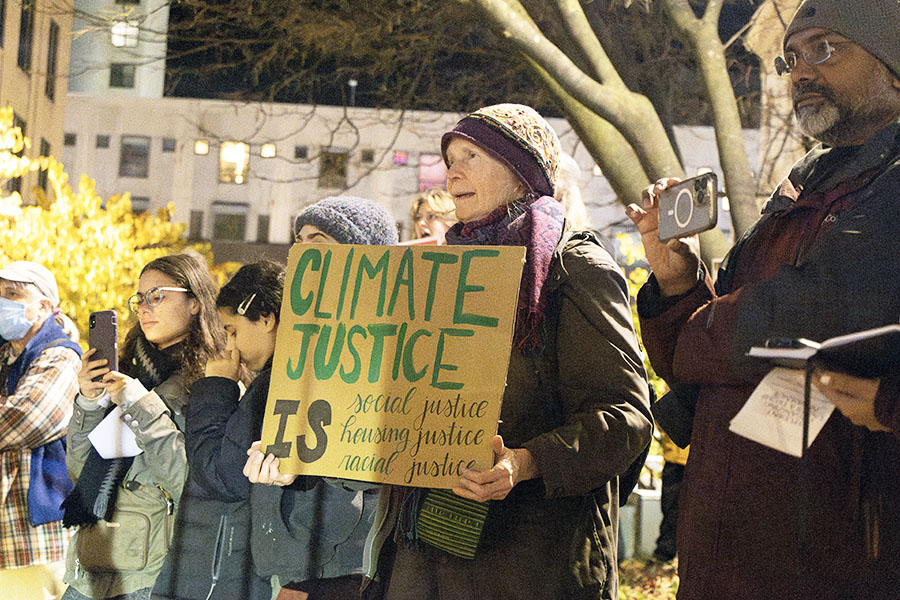In September, Rebecca Evans, director of sustainability for the City of Ithaca, posted on LinkedIn that she scrapped the city’s Climate Action Plan she wrote in 2023 and will rewrite it over the next six months to include more climate justice-oriented goals.
While Evans said she is unsure what the next steps of the new CAP will be, residents have been urging for a community-focused plan that would bring in local climate and social justice organizations to help plan and combat climate change.
Evans announced in her LinkedIn post that she changed the five sectors of resiliency in the CAP to the five sectors of climate justice: labor, housing, racial equity, electrical reliability and emergency response and evacuation. Evans said that while she is rewriting the CAP, the original version of the CAP was not adopted by the city of Ithaca and is not available to the general public.
Evans said the previous Ithaca Green New Deal and CAP did not resonate with many communities in Ithaca. She said it ignored struggles people in Ithaca were facing that were amplified by the COVID-19 pandemic like job loss and struggles with maintaining housing.
“The truth was that most people didn’t have the capacity to have climate change as even on their top five priority list, which is totally valid,” Evans said.
Evans said she is both excited and intimidated to figure out how to structure the CAP, which will include an emergency response plan for climate disasters like flooding and power outages.
“How do we put the resources in place so that we can evacuate people if we need to, so we can get people the resources they need?” Evans said. “We’ll be doing some risk assessments to figure out how exactly climate change is going to impact [our community].”
Evans said the previous CAP focused on racial justice, energy efficiency, decarbonization of grid fuel, electrification of transportation, waste reduction and carbon capture. The new CAP focuses on ensuring good living wages, safe housing for all, racial justice, improving public health, rapid emergency response plans and electrical reliability.
“So what does [the new CAP] mean to all of the strategies that were encompassed in that previous climate action plan?” Evans said. “They’re still there, just further down the list [of climate needs]. All of those mitigation strategies are now just packed into those different sectors. So for example in order to provide safe, affordable housing we need to ensure that cooling is accessible, the best way we can do that is electrification.”
The change comes after the Common Council unanimously passed Justice50 on May 1. Justice50 is a climate justice policy that allocates 50% of the city’s capital funding per year to climate justice communities. It will also require 40% of participants in future city workforce development programs to be from climate justice communities. According to a budget summary released Nov. 6, the Common Council allocated $550,000 to capital projects to Justice50 initiatives in 2025.
According to the National Institute of Health, racially and socioeconomically marginalized communities in the U.S. experience greater impacts from flood events, extreme heat and infectious diseases. Ithaca has a poverty rate of 33.1% and according to a Cornell International Labor Relations Study in 2023, 58.8% of Black residents make less than a living wage in Ithaca.
Next steps for the CAP and Justice50
Kayla Matos, deputy director of the South Side Community Center and Ward 1 alderperson, said an initiative was approved for a $550,000 capital project to help fund a low-barrier navigation center for people experiencing homelessness in Ithaca. Matos said the project allowed for the city to reach its Justice50 goal of allocating 50% of capital funds to climate justice communities.
Savannah Vega, sustainability planner for the City of Ithaca, said that the South Side is not officially designated as a climate justice community and that Ithaca will conduct community surveys to be able to designate which neighborhoods are categorized as such.
“We did a preliminary look at some existing data … to help inform the current budget season decisions,” Vega said. “Would I be surprised if South Side [was a climate justice community]? No, but we can’t designate any [community] yet.”
Matos said that listening sessions and focus groups are an ideal way to build the new CAP. She said it is important to use institutions in the Ithaca community like the SSCC to host the listening groups.
“Within our Justice50 framework, 10% of our budget … essentially would go to participatory budgeting and [we could pay] folks to interact with us and interact in these focus groups and share these thoughts and that could go a long way [with the CAP planning],” Matos said.
Vega said the city has not made any firm decisions on how to conduct the participatory budgeting process yet, but said that paying residents to give their input on what to fund through Justice50 could be a possibility.
Matos also said the SSCC could be turned into a resiliency hub for climate-related issues. Matos said the SSCC wants to purchase heating and cooling stations so Ithaca residents who do not have access to those resources can shelter during extreme heat or cold.
“Where [the resiliency hub] ties into the [CAP] is that city resources are being used to essentially develop an institution [that] provides to these marginalized communities … and through these resources, they will be able to better serve the community’s needs,” Matos said.
Matos said the new CAP will serve as a more equitable framework for the IGND and the city will be able to achieve more climate justice action in disenfranchised communities.
Sustainability and Climate Justice Commission Meeting
In a slideshow titled “Dignity Toward Decarbonization,” Evans presented her plans to change the CAP to the Sustainability and Climate Justice Commission on Oct. 21.
“All of the concerns about climate change have always come down to how they will ultimately impact people,” Evans said during the presentation. “So why don’t our climate goals reflect that? Localities, cities, states … all over the world have climate-related goals and they all frame it within the context of a net reduction in carbon as the number one priority.”
Evans said that framing the CAP in this way was problematic because it focused on the parts of sustainability that people are less likely to relate to, like emissions.
“It’s often really hard to grasp for the average person to understand the impact for future generations,” Evans said.” That’s often how we’re talking about climate change but for most people, we’re not worried about future generations. We’re worried about putting food on the table.”
Sioban Hull, a board member of the Sustainability and Climate Justice Commission, said during the Oct. 21 meeting that many of the public comments made by community members at the meeting were about the lack of community involvement from Ithaca residents. Many public comments urged the commission to create a CAP that includes community involvement from various organizations and individuals in Ithaca.
“[They feel that] the city is pursuing these large projects that are perhaps decreasing carbon but aren’t really tangibly connected with their lives in any way,” Hull said. “I’m excited about this as a new avenue for people to actually be able to shape the type of work that the city is doing.”
Hull said in an interview with The Ithacan that she has been doing organizing work with the Sunrise Movement Ithaca since 2021 and said the commission has been meeting for over a year now to provide input to the city about climate action.
Hull said the city and climate organizations have been struggling to get information initiatives out to community members, particularly the ones who are most impacted by climate change.
“When we are talking about the [IGND], it feels really disconnected from people’s lives,” Hull said. “I think this shift in the CAP is … a direct effort to try and engage these communities who aren’t already being reached.”










